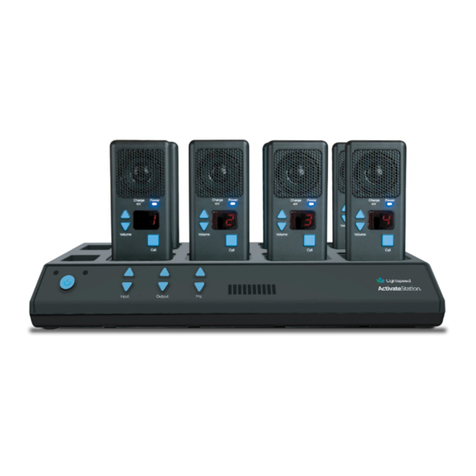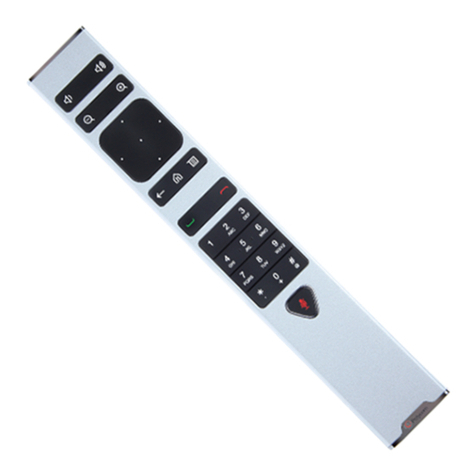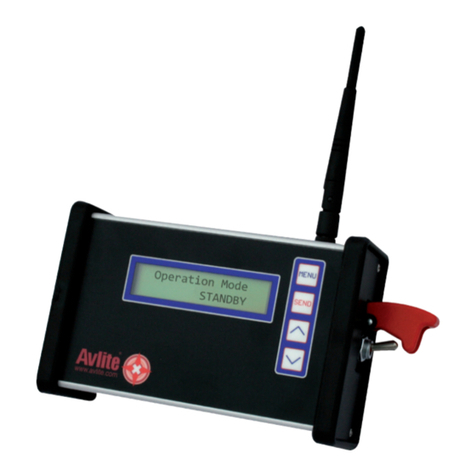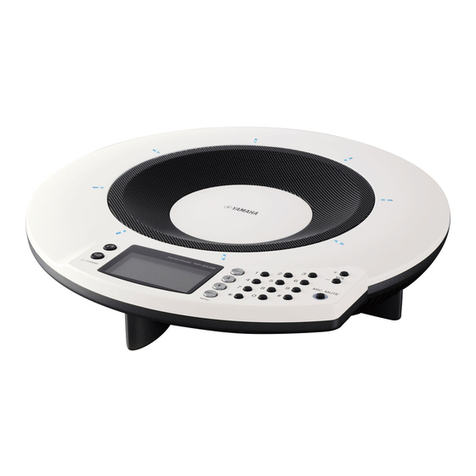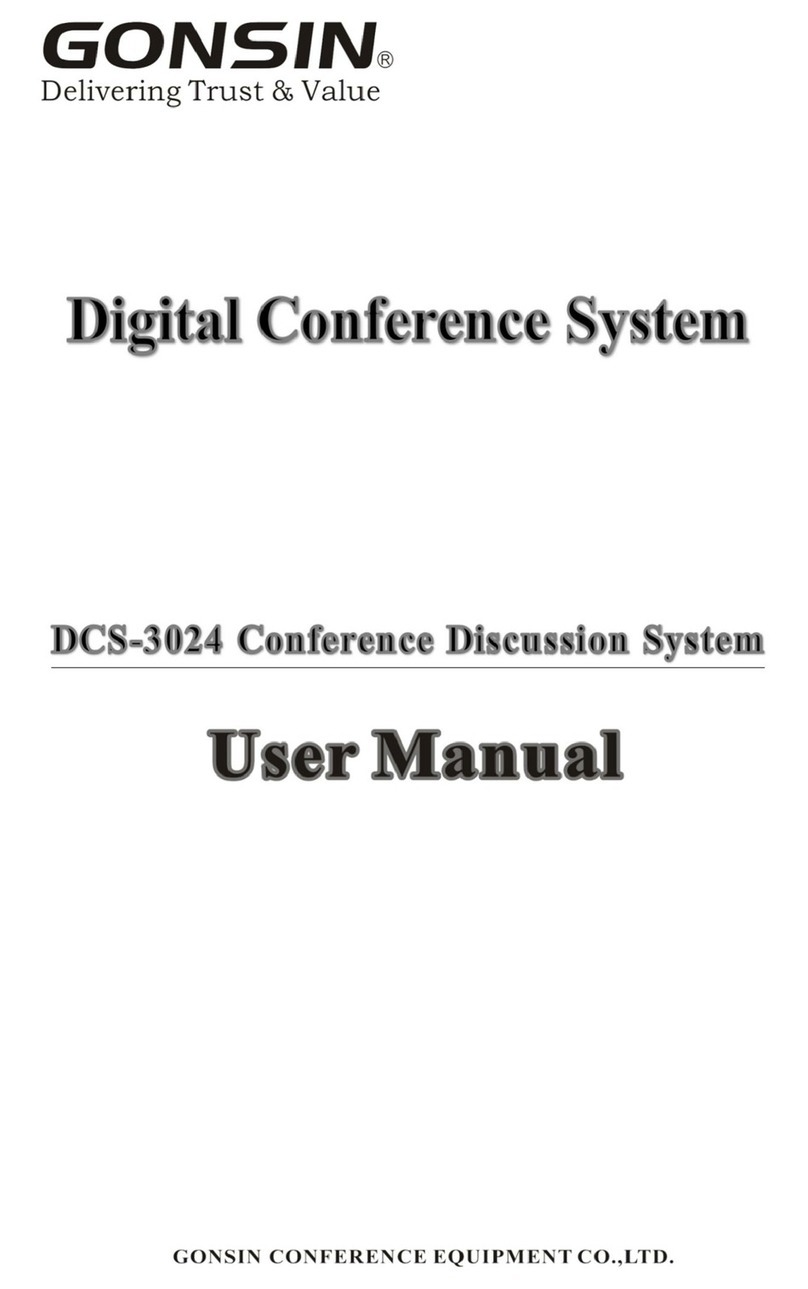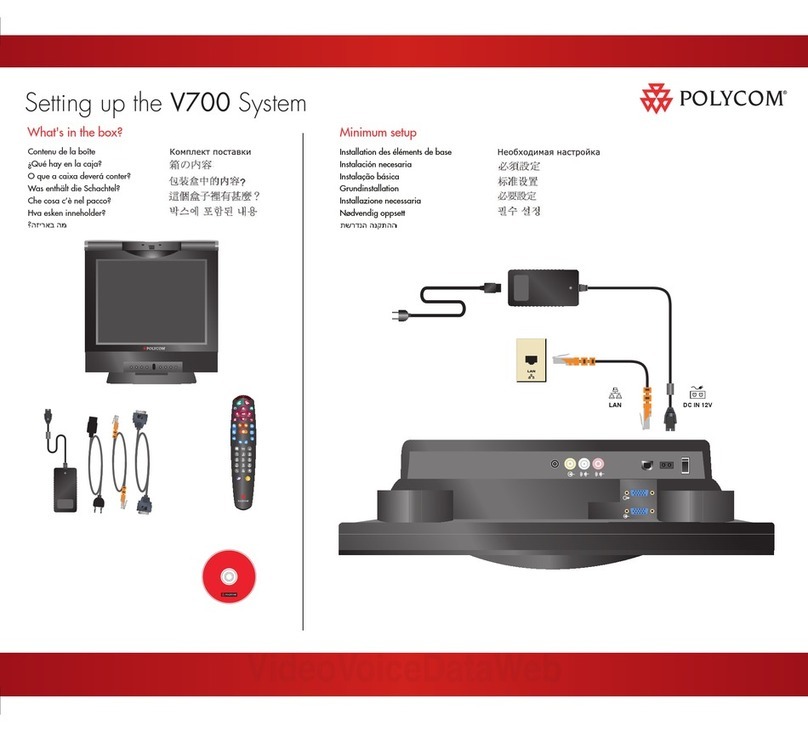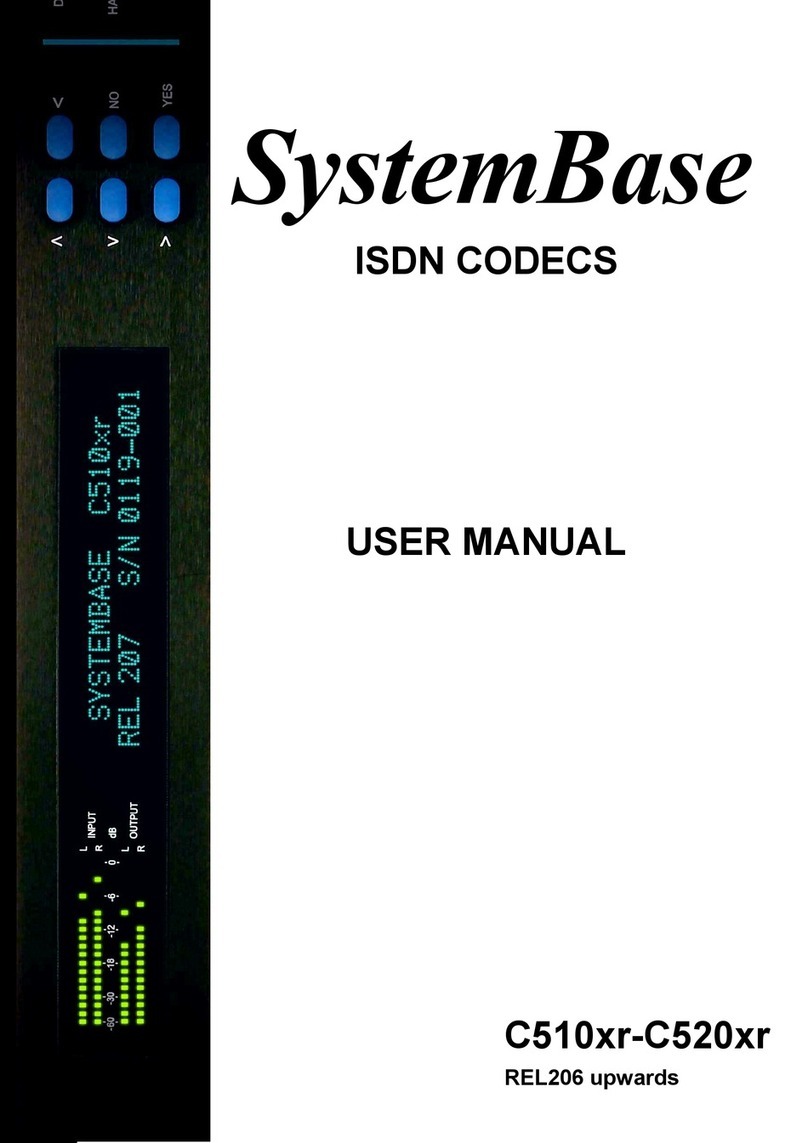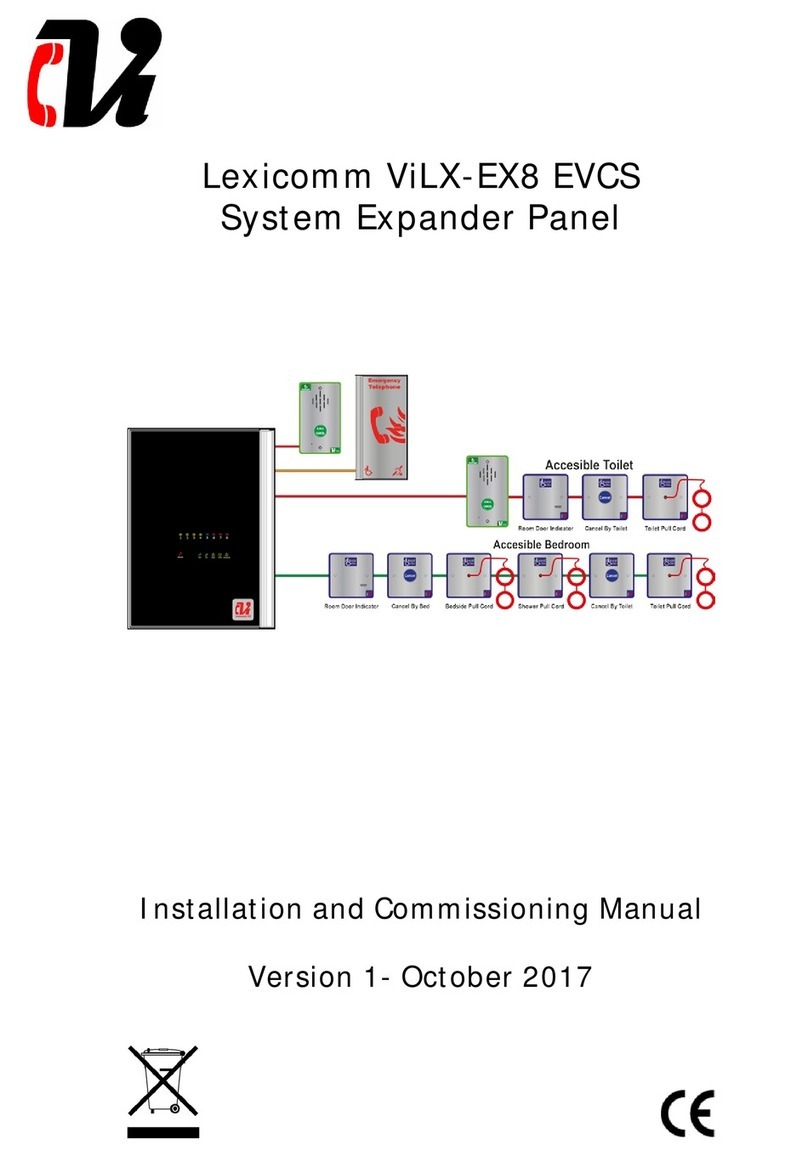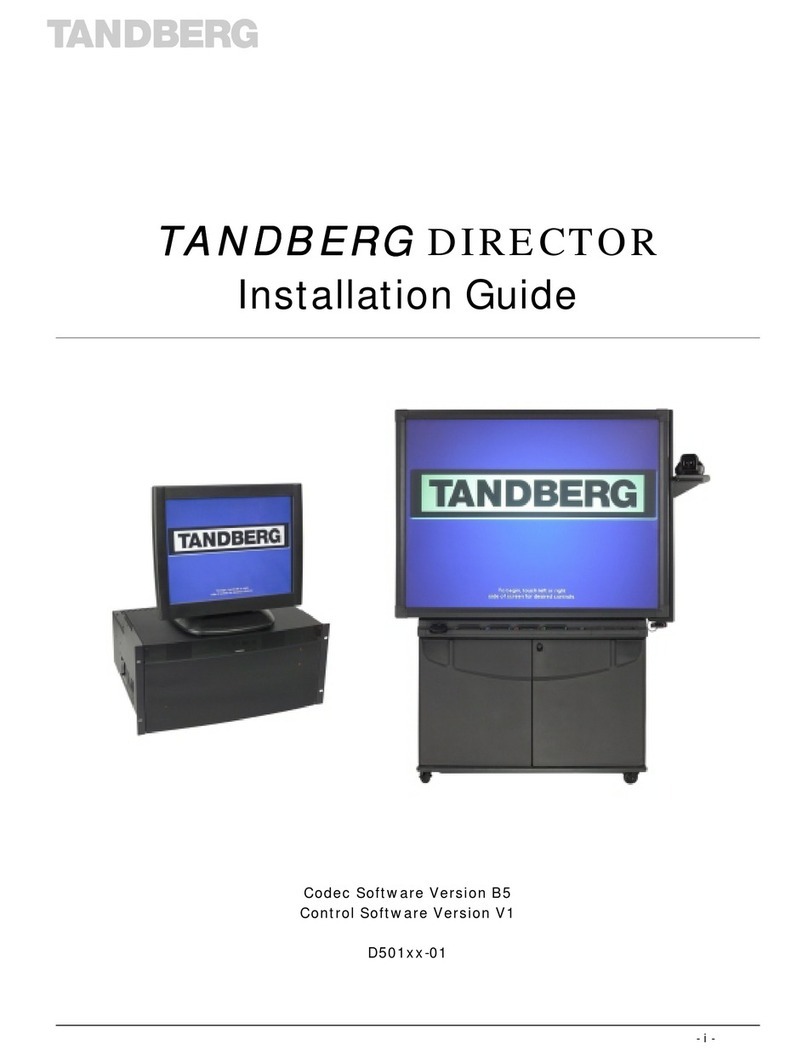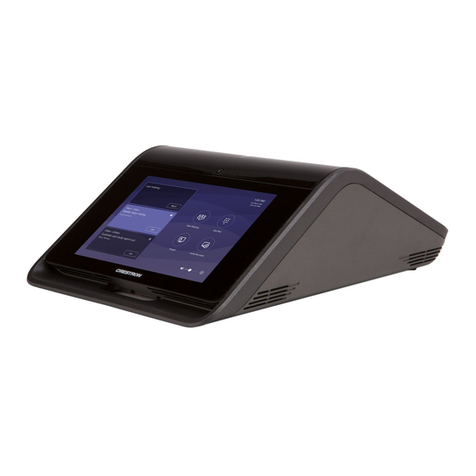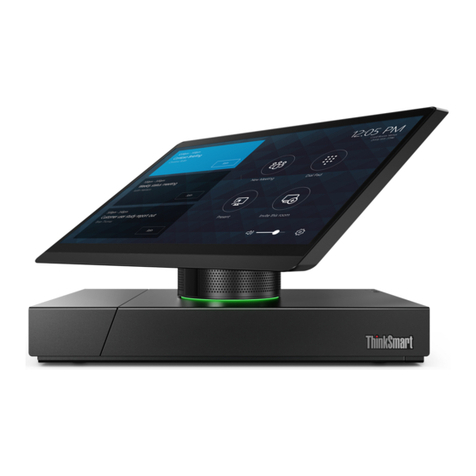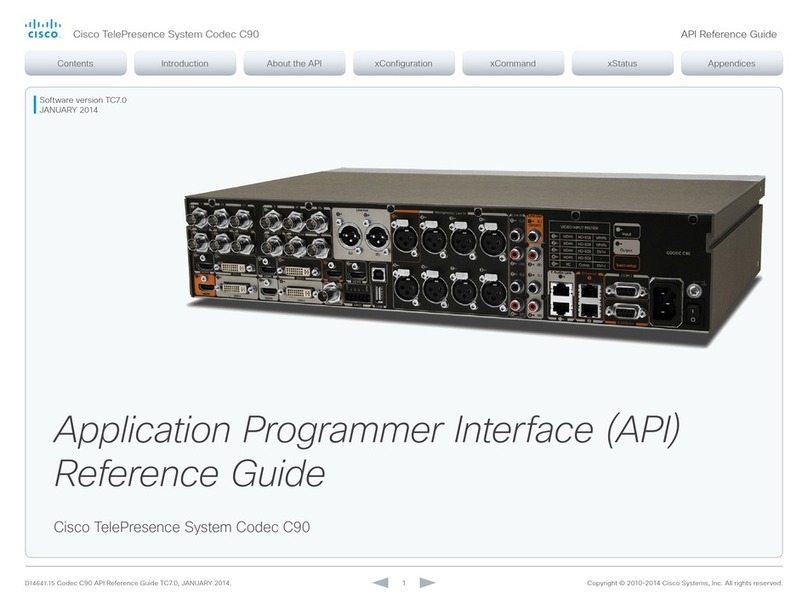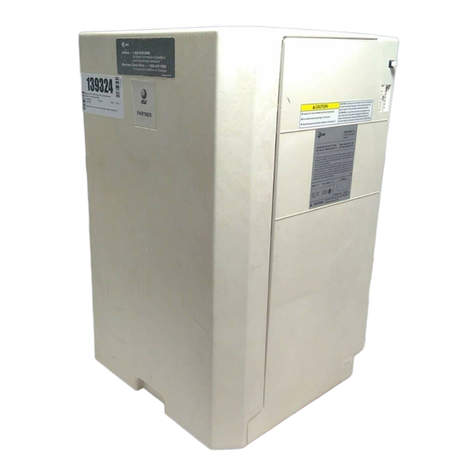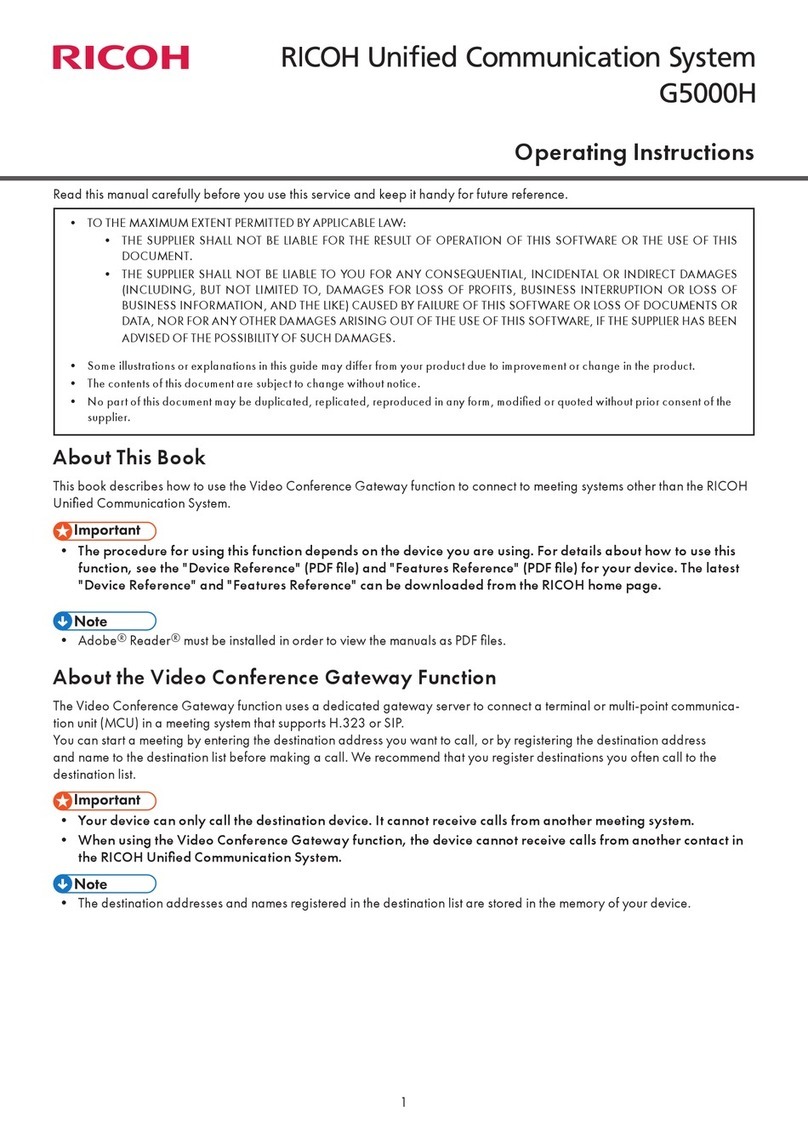Cirrus Logic WM8940 User manual

Mono CODEC with Speaker Driver
http://www.cirrus.com
Copyright ©Cirrus Logic, Inc., 2006–2022
(All Rights Reserved)
Rev 4.4
JAN 2022
WM8940
DESCRIPTION
The WM8940 is a low power, high quality mono CODEC
designed for portable applications such as digital still cameras
or camcorders.
The device integrates support for a differential or single ended
mic, and includes drivers for speakers or headphone, and
mono line output. External component requirements are
reduced as no separate microphone or headphone amplifiers
are required.
Advanced Sigma Delta Converters are used along with digital
decimation and interpolation filters to give high quality audio at
sample rates from 8 to 48ks/s. A selectable high pass filter and
four fully-programmable notch filters are available in the ADC
path. An advanced mixed signal ALC function with noise gate
is provided, while readback of PGA gain during ALC operation
is supported. The digital audio interface supports A-law and -
law companding.
An on-chip PLL is provided to generate the required Master
Clock from an external reference clock. The PLL clock can
also be output if required elsewhere in the system.
The WM8940 operates at supply voltages from 2.5 to 3.6V,
although the digital supplies can operate at voltages down to
1.71V to save power. Different sections of the chip can also be
powered down under software control using the selectable two
or three wire control interface.
WM8940 is supplied in a very small 4x4mm QFN package,
offering high levels of functionality in minimum board area, with
high thermal performance.
FEATURES
•Mono CODEC:
•Audio sample rates:8, 11.025, 16, 22.05, 24, 32, 44.1, 48kHz
•DAC SNR 98dB, THD -84dB (‘A’-weighted @ 8 –48ks/s)
•ADC SNR 94dB, THD -80dB (‘A’-weighted @ 8 –48ks/s)
•On-chip Headphone/Speaker Driver
- 40mW output power into 16
- BTL speaker drive 0.4W into 8
•Additional MONO Line output
•Multiple analogue or ‘Aux’ inputs, plus analogue bypass path
•Mic Preamps:
•Differential or single end Microphone Interface
- Programmable preamp gain
- Pseudo differential inputs with common mode rejection
- Programmable ALC / Noise Gate in ADC path
•Low-noise bias supplied for electret microphones
OTHER FEATURES
•Digital Playback Limiter
•Programmable high pass filter (wind noise reduction)
•4 notch filters (narrowband noise suppression)
•On-chip PLL
•Low power, low voltage
- 2.5V to 3.6V (digital: 1.71V to 3.6V)
•4x4x0.9mm 24 lead QFN package
APPLICATIONS
•Digital still cameras and camcorders
•General purpose mono audio CODEC

WM8940
2Rev 4.4
BLOCK DIAGRAM
CONTROL
INTERFACE
CSB/GPIO
SDIN
SCLK
MICBIAS
DGND
AVDD
AGND
VMID
250k250k
ADCREF,
DACREF
I2S or PCM
INTERFACE
A-law and u-law support
FRAME
ADCDAT
ADC
DAC
DIGITAL
FILTERS
Volume
Digital
Playback
Limiter
ADC
DIGITAL
FILTERS
Volume
Wind Noise
Filter
4 Notch
Filters
ALC /
Limiter
DACDAT
50k 50k
4k 5k
BYPASS PATH
MCLK
DCVDD SPKVDDSPKGND
BCLK
SPKOUTP
SPKOUTN
L - (-R)
= L+R
MONOOUT
AUX
20k
20k
analogue
inputs
Rbias
Mic
NOISY
GND -12dB to +35.25dB,
0.75dB steps
MODE / GPIO
MICN
MICP
MIC
INPUT
PGA
INPUT
BOOST
MIXER
0dB/10dB
0dB/10dB
PGA Gain
Readback GPIO
PLL
-12dB to +6dB, 3dB steps
-12dB to +6dB, 3dB steps
0dBor +20dB
DSP CORE OUTPUTS
-57dB to +6dB,
1dBsteps
DAC
MIC +
or additional line input
MIC -
or single-endedMIC input
WM8940
DBVDD

WM8940
Rev 4.4 3
TABLE OF CONTENTS
DESCRIPTION................................................................................................................ 1
FEATURES..................................................................................................................... 1
APPLICATIONS ............................................................................................................. 1
BLOCK DIAGRAM ......................................................................................................... 2
TABLE OF CONTENTS.................................................................................................. 3
PIN CONFIGURATION ................................................................................................... 6
ORDERING INFORMATION........................................................................................... 6
PIN DESCRIPTION......................................................................................................... 7
ABSOLUTE MAXIMUM RATINGS ................................................................................. 8
RECOMMENDED OPERATING CONDITIONS.............................................................. 8
ELECTRICAL CHARACTERISTICS .............................................................................. 9
TERMINOLOGY.......................................................................................................................11
AUDIO PATHS OVERVIEW ......................................................................................... 12
POWER CONSUMPTION............................................................................................. 13
SIGNAL TIMING REQUIREMENTS ............................................................................. 14
SYSTEM CLOCK TIMING........................................................................................................14
AUDIO INTERFACE TIMING –MASTER MODE ....................................................................15
AUDIO INTERFACE TIMING –SLAVE MODE........................................................................16
CONTROL INTERFACE TIMING –3-WIRE MODE.................................................................17
CONTROL INTERFACE TIMING –2-WIRE MODE.................................................................18
DEVICE DESCRIPTION ............................................................................................... 19
INTRODUCTION......................................................................................................................19
FEATURES....................................................................................................................................................................................19
MICROPHONE INPUTS................................................................................................................................................................19
PGA AND ALC OPERATION ........................................................................................................................................................19
AUX INPUT....................................................................................................................................................................................19
ADC ...............................................................................................................................................................................................19
HI-FI DAC ......................................................................................................................................................................................19
DIGITAL FILTERING.....................................................................................................................................................................19
OUTPUT MIXING AND VOLUME ADJUST ..................................................................................................................................19
AUDIO INTERFACES....................................................................................................................................................................19
CONTROL INTERFACES .............................................................................................................................................................20
CLOCKING SCHEMES .................................................................................................................................................................20
POWER CONTROL.......................................................................................................................................................................20
INPUT SIGNAL PATH..............................................................................................................20
MICROPHONE INPUTS................................................................................................................................................................20
INPUT PGA VOLUME CONTROL.................................................................................................................................................22
AUXILIARY INPUT ........................................................................................................................................................................22
INPUT BOOST...............................................................................................................................................................................23
MICROPHONE BIASING CIRCUIT...............................................................................................................................................24
ANALOGUE TO DIGITAL CONVERTER (ADC)......................................................................25
ADC DIGITAL FILTERS ................................................................................................................................................................25
SELECTABLE HIGH PASS FILTER..............................................................................................................................................26
PROGRAMMABLE NOTCH FILTERS ..........................................................................................................................................27
DIGITAL ADC VOLUME CONTROL .............................................................................................................................................29
INPUT LIMITER / AUTOMATIC LEVEL CONTROL (ALC)......................................................29
NORMAL MODE............................................................................................................................................................................32
LIMITER MODE.............................................................................................................................................................................32
ATTACK AND DECAY TIMES.......................................................................................................................................................33
NORMAL MODE............................................................................................................................................................................33
LIMITER MODE.............................................................................................................................................................................34

WM8940
4Rev 4.4
MINIMUM AND MAXIMUM GAIN..................................................................................................................................................35
ALC HOLD TIME (NORMAL MODE ONLY)..................................................................................................................................36
PEAK LIMITER..............................................................................................................................................................................38
NOISE GATE (NORMAL MODE ONLY) .......................................................................................................................................39
OUTPUT SIGNAL PATH..........................................................................................................41
DIGITAL HI-FI DAC VOLUME CONTROL ....................................................................................................................................41
HI-FI DIGITAL TO ANALOGUE CONVERTER (DAC) ..................................................................................................................42
AUTOMUTE...................................................................................................................................................................................42
DAC OUTPUT LIMITER ................................................................................................................................................................42
VOLUME BOOST..........................................................................................................................................................................43
ANALOGUE OUTPUTS ...........................................................................................................45
SPKOUTP/SPKOUTN OUTPUTS.................................................................................................................................................45
ZERO CROSS TIMEOUT..............................................................................................................................................................46
MONO MIXER AND OUTPUT.......................................................................................................................................................47
ENABLING THE OUTPUTS ..........................................................................................................................................................47
UNUSED ANALOGUE INPUTS/OUTPUTS ..................................................................................................................................48
OUTPUT SWITCH ...................................................................................................................49
THERMAL SHUTDOWN ...............................................................................................................................................................49
SPEAKER OUTPUT......................................................................................................................................................................49
HEADPHONE OUTPUT ................................................................................................................................................................50
MONO OUTPUT............................................................................................................................................................................50
DIGITAL AUDIO INTERFACES ...............................................................................................51
MASTER AND SLAVE MODE OPERATION.................................................................................................................................51
AUDIO DATA FORMATS ..............................................................................................................................................................51
AUDIO INTERFACE CONTROL ...................................................................................................................................................53
LOOPBACK...................................................................................................................................................................................55
AUDIO SAMPLE RATES .........................................................................................................55
MASTER CLOCK AND PHASE LOCKED LOOP (PLL)...........................................................55
INTEGER N DIVISION...................................................................................................................................................................57
FRACTIONAL K MODE.................................................................................................................................................................57
EXAMPLE PLL CONFIGURATION: ..............................................................................................................................................57
COMPANDING.........................................................................................................................58
GENERAL PURPOSE INPUT/OUTPUT..................................................................................60
CONTROL INTERFACE ..........................................................................................................61
SELECTION OF CONTROL MODE AND 2-WIRE MODE ADDRESS..........................................................................................61
USE OF MODE AS A GPIO PIN IN 3-WIRE MODE .....................................................................................................................61
3-WIRE SERIAL CONTROL MODE..............................................................................................................................................62
READBACK IN 3-WIRE MODE.....................................................................................................................................................62
2-WIRE SERIAL CONTROL MODE..............................................................................................................................................63
RESETTING THE CHIP...........................................................................................................63
POWER SUPPLIES .................................................................................................................64
RECOMMENDED POWER UP/DOWN SEQUENCE....................................................................................................................64
POWER MANAGEMENT.........................................................................................................66
VMID..............................................................................................................................................................................................66
BIASEN..........................................................................................................................................................................................66
ESTIMATED SUPPLY CURRENTS..............................................................................................................................................66

WM8940
Rev 4.4 5
POP MINIMISATION................................................................................................................67
REGISTER MAP........................................................................................................... 68
REGISTER BITS BY ADDRESS..............................................................................................69
DIGITAL FILTER CHARACTERISTICS ....................................................................... 80
TERMINOLOGY.......................................................................................................................80
DAC FILTER RESPONSES.....................................................................................................81
ADC FILTER RESPONSES.....................................................................................................81
HIGHPASS FILTER .................................................................................................................82
NOTCH FILTERS AND LOW-PASS FILTER...........................................................................82
NOTCH FILTER WORKED EXAMPLE....................................................................................84
APPLICATIONS INFORMATION ................................................................................. 85
RECOMMENDED EXTERNAL COMPONENTS......................................................................85
PACKAGE DIAGRAM .................................................................................................. 86
IMPORTANT NOTICE .................................................................................................. 87
REVISION HISTORY .................................................................................................... 88

WM8940
6Rev 4.4
PIN CONFIGURATION
MCLK
MODE / GPIO
FRAME
BCLK
DACDAT
ADCDAT
1
2
3
4
5
6
18
17
16
15
14
13
121110987
192021222324
SPKOUTN
VMID
SPKVDD
AUX
MICN
MICP
AVDD
AGND
DGND
DCVDD
DBVDD
MICBIAS SPKGND
MONOOUT
SCLK
CSB/GPIO
SDIN
SPKOUTP
TOP VIEW
ORDERING INFORMATION
ORDER CODE
TEMPERATURE
RANGE
PACKAGE
MOISTURE
SENSITIVITY
LEVEL
PACKAGE BODY
TEMPERATURE
WM8940CGEFL/V
-25C to +85C
24-lead QFN (4x4x0.9mm)
(Pb-free)
MSL3
260oC
WM8940CGEFL/RV
-25C to +85C
24-lead QFN (4x4x0.9mm)
(Pb-free, tape and reel)
MSL3
260oC
WM8940KGEFL/V (see Note)
-25C to +85C
24-lead QFN (4x4x0.9mm)
(Pb-free)
MSL3
260oC
WM8940KGEFL/RV (see Note)
-25C to +85C
24-lead QFN (4x4x0.9mm)
(Pb-free, tape and reel)
MSL3
260oC
Note:
1. Order code denotes products associated with PCN-2020-141.

WM8940
Rev 4.4 7
PIN DESCRIPTION
PIN
NAME
TYPE
DESCRIPTION
1
MICBIAS
Analogue Output
Microphone bias
2
AVDD
Supply
Analogue supply
3
AGND
Supply
Analogue ground
4
DCVDD
Supply
Digital Supply (Core)
5
DBVDD
Supply
Digital supply (Input/Output)
6
DGND
Supply
Digital ground
7
ADCDAT
Digital Output
ADC digital audio data output
8
DACDAT
Digital Input
DAC digital audio data input
9
FRAME
Digital Input / Output
DAC and ADC sample rate clock or frame synch
10
BCLK
Digital Input / Output
Digital audio port clock
11
MCLK
Digital Input
Master clock input
12
CSB/GPIO
Digital Input / Output
3-Wire control interface chip select or GPIO pin.
13
SCLK
Digital Input
3-Wire control interface clock Input / 2-Wire control interface clock
input
14
SDIN
Digital Input / Output
3-Wire control interface data Input / 2-Wire control interface data input
15
MODE / GPIO
Digital Input
Control interface mode selection pin or GPIO pin.
16
MONOOUT
Analogue Output
Mono output
17
SPKOUTP
Analogue Output
Speaker output positive
18
SPKGND
Supply
Speaker ground
19
SPKOUTN
Analogue Output
Speaker output negative
20
SPKVDD
Supply
Speaker supply
21
AUX
Analogue Input
Auxiliary analogue input
22
VMID
Reference
Decoupling for midrail reference voltage
23
MICN
Analogue Input
Microphone negative input (common mode)
24
MICP
Analogue Input
Microphone positive input
Note:
1. It is recommended that the QFN ground paddle should be connected to analogue ground on the application PCB.
2. Refer to the application note WAN_0118 on “Guidelines on How to Use QFN Packages and Create Associated PCB Footprints”

WM8940
8Rev 4.4
ABSOLUTE MAXIMUM RATINGS
Absolute Maximum Ratings are stress ratings only. Permanent damage to the device may be caused by continuously operating at or
beyond these limits. Device functional operating limits and guaranteed performance specifications are given under Electrical
Characteristics at the test conditions specified.
ESD Sensitive Device. This device is manufactured on a CMOS process. It is therefore generically susceptible to
damage from excessive static voltages. Proper ESD precautions must be taken during handling and storage of this
device.
Cirrus Logic tests its package types according to IPC/JEDEC J-STD-020B for Moisture Sensitivity to determine acceptable storage
conditions prior to surface mount assembly. These levels are:
MSL1 = unlimited floor life at <30C / 85% Relative Humidity. Not normally stored in moisture barrier bag.
MSL2 = out of bag storage for 1 year at <30C / 60% Relative Humidity. Supplied in moisture barrier bag.
MSL3 = out of bag storage for 168 hours at <30C / 60% Relative Humidity. Supplied in moisture barrier bag.
The Moisture Sensitivity Level for each package type is specified in Ordering Information.
CONDITION
MIN
MAX
DBVDD, DCVDD, AVDD, SPKVDD supply voltages
-0.3V
+4.2
Voltage range digital inputs
DGND -0.3V
DVDD +0.3V
Voltage range analogue inputs
AGND -0.3V
AVDD +0.3V
Operating temperature range, TA
-25C
+85C
Storage temperature prior to soldering
30C max / 85% RH max
Storage temperature after soldering
-65C
+150C
Notes:
1. Analogue and digital grounds must always be within 0.3V of each other.
2. All digital and analogue supplies are completely independent from each other.
RECOMMENDED OPERATING CONDITIONS
PARAMETER
SYMBOL
TEST CONDITIONS
MIN
TYP
MAX
UNIT
Digital supply range (Core)
DCVDD
1.71
3.6
V
Digital supply range (Buffer)
DBVDD
1.71
3.6
V
Analogue supplies range
AVDD, SPKVDD1
2.5
3.6
V
Ground
DGND,AGND, SPKGND
0
V
Notes:
1. Analogue supply voltages must be ≥the digital supply voltages
2. DBVDD must be ≥DCVDD

WM8940
Rev 4.4 9
ELECTRICAL CHARACTERISTICS
Test Conditions
DCVDD = 1.8V, AVDD = DBVDD = 3.3V, SPKVDD =3.3V, TA = +25oC, 1kHz signal, fs = 48kHz, 24-bit audio data unless otherwise
stated.
PARAMETER
SYMBOL
TEST CONDITIONS
MIN
TYP
MAX
UNIT
Microphone Input PGA Inputs (MICN, MICP)
INPPGAVOL and PGABOOST = 0dB
Full-scale Input Signal Level –Single-
ended input via LIN/RIN 1
AVDD/3.3
Vrms
Full-scale Input Signal Level –
Pseudo-differential input 1,2
AVDD*0.7/
3.3
Vrms
Input PGA equivalent input noise
INPPGAVOL = +35.25dB
No input signal
0 to 20kHz
76.5
dB
MICN input resistance
INPPGAVOL = +35.25dB
2
k
MICN input resistance
INPPGAVOL = 0dB
58.5
k
MICN input resistance
INPPGAVOL = -12dB
97.5
k
MICP input resistance
All gain settings
124.5
k
Input Capacitance
All analogue input pins
10
pF
Maximum Input PGA Programmable
Gain
Gain adjusted by
INPPGAVOL
+33.25
+35.25
+37.25
dB
Minimum Input PGA Programmable
Gain
Gain adjusted by
INPPGAVOL
-14
-12
-10
dB
Programmable Gain Step Size
Guaranteed monotonic
0.75
dB
Input PGA Mute Attenuation
INPPGAMUTE
92
dB
Input Gain Boost
PGABOOST= 0
0
dB
Input Gain Boost
PGABOOST = 1
+20
dB
Auxiliary Analogue Inputs (AUX)
Full-scale Input Signal Level 2
AVDD/3.3
Vrms
Input Resistance
Input boost and mixer
enabled, at 0dB gain
20
k
Input Capacitance
All analogue Inputs
10
pF
Maximum Gain from AUX input PGA
mixers
Gain adjusted by
AUX2BOOSTVOL
+4.0
+6
+7.5
dB
Minimum Gain from AUX input PGA
mixers
Gain adjusted by
AUX2BOOSTVOL
-14
-12
-9
dB
AUX2BOOSTVOL step size
Guaranteed monotonic
3
dB
Analogue to Digital Converter (ADC) - Input from MICN and MICP in differential configuration to input PGA
INPPGAVO, PGABOOST and ADCVOL = 0dB
Signal to Noise Ratio 3
SNR
A-weighted
AVDD=3.3V
88
91
dB
Total Harmonic Distortion4
THD
-1dBV Input
AVDD=3.3V
-80
-75
dB
Total Harmonic Distortion + Noise 5
THD+N
-1dBV Input
AVDD=3.3V
-75
-68
dB
Channel Separation 6
1kHz full scale input signal
100
dBFS

WM8940
10 Rev 4.4
Test Conditions
DCVDD = 1.8V, AVDD = DBVDD = 3.3V, SPKVDD =3.3V, TA = +25oC, 1kHz signal, fs = 48kHz, 24-bit audio data unless otherwise
stated.
PARAMETER
SYMBOL
TEST CONDITIONS
MIN
TYP
MAX
UNIT
Digital to Analogue Converter (DAC) to MONO Output with 10k/ 50pF load and DACVOL 0dB
Full-scale output 1
DACVOL = 0dB
AVDD/3.3
Vrms
Signal to Noise Ratio 3
SNR
A-weighted
AVDD=SPKVDD=3.3V
93
98
dB
Total Harmonic Distortion 4
THD
0dBFS input
AVDD=SPKVDD=3.3V
-80
-75
dBFS
Total Harmonic Distortion + Noise 5
THD+N
0dBFS input
AVDD=SPKVDD=3.3V
-78
-74
dBFS
Channel Separation 6
1kHz signal
100
dB
MICP and MICN input PGA to input boost stage into 10k/ 50pF load on SPKOUTP and SPKOUTP
INPPGAVOL, PGABOOST = 0dB
Full-scale output voltage, 0dB gain
SPKVDD/3.3
Vrms
Signal to Noise Ratio 3
SNR
A-weighted
AVDD=SPKVDD=3.3V
94
99
dB
Total Harmonic Distortion 4
THD
full-scale signal
AVDD=SPKVDD=3.3V
-90
-85
dBFS
Total Harmonic Distortion + Noise 5
THD+N
full-scale signal
AVDD=SPKVDD=3.3V
-87
-82
dBFS
Channel Separation 6
100
dB
DAC to Speaker Output (SPKOUTP, SPKOUTN with 8bridge tied load) Bypass mode
Output Power
Po
Output power is closely correlated with THD see below
Total Harmonic Distortion 4
THD
Po=350mW, RL = 8Ω
SPKVDD=3.3V
0.03
-70
-60
%
dB
Signal to Noise Ratio 3
SNR
A-weighted
SPKVDD=3.3V
93.5
98
dB
Power Supply Rejection Ratio
(50Hz-22kHz)
PSRR
RL = 8BTL
50
dB
AUX In to Headphone Output (SPKOUTP, SPKOUTN with 16R resistive load to GND) Bypass mode
Signal to Noise Ratio 3
SNR
A-weighted
SPKVDD=3.3V
95
99
dB
Total Harmonic Distortion 4
THD
Po=20mW, RL = 16Ω
SPKVDD=3.3V
0.02
-74
-67
%
dB
Microphone Bias
Bias Voltage
MBVSEL=0
0.9*AVDD
V
MBVSEL=1
0.65*AVDD
V
Bias Current Source
for VMICBIAS within +/-3%
3
mA
Output Noise Voltage
1kHz to 20kHz
15
nV/Hz
Digital Input / Output
Input HIGH Level
VIH
0.7
DBVDD
V
Input LOW Level
VIL
0.3DBVDD
V
Output HIGH Level
VOH
IOL=1mA
0.9
DBVDD
V
Output LOW Level
VOL
IOH-1mA
0.1xDBVDD
V
Input Capacitance
All digital pins
10
pF

WM8940
Rev 4.4 11
TERMINOLOGY
1. Full-scale input and output levels scale in relation to AVDD or SPKVDD depending upon the input or output used. For
example, when AVDD = 3.3V, 0dBFS = 1Vrms (0dBV). When AVDD < 3.3V the absolute level of 0dBFS will decrease with a
linear relationship to AVDD.
2. Input level to RIP and LIP in differential configurations is limited to a maximum of -3dB or performance will be reduced.
3. Signal-to-noise ratio (dB) –SNR is the difference in level between a reference full scale output signal and the device output
with no signal applied. This ratio is also called idle channel noise. (No Auto-zero or Automute function is employed in achieving
these results).
4. Total Harmonic Distortion (dB) –THD is the difference in level between a reference output signal and the first seven harmonics
of that signal. The reference output signal need not be at full scale amplitude; THD is typically measured using an output
power of 20mW into a 16ohm load, corresponding to a reference signal level of -5dB. However the stated test conditions
include input signal level, signal gain settings, output load characteristics and power supply voltages To calculate the ratio, the
fundamental frequency of the output signal is notched out and an RMS value of the next seven harmonics is calculated.
5. Total Harmonic Distortion plus Noise (dB) –THD+N is the difference in level between a reference output signal and the sum of
the harmonics, wide-band noise and interference on the output signal. To calculate the ratio, the fundamental frequency of the
output signal is notched out and an RMS value of the total harmonics, wide-band noise and interference is calculated.
6. Channel Separation (dB) –Also known as Cross-Talk. This is a measure of the amount one channel is isolated from the other.
Normally measured by sending a full scale signal down

WM8940
12 Rev 4.4
AUDIO PATHS OVERVIEW
Digital Core
DACPOL
R10[0]
DAC
AVDD
AGND
VREF+
VREF-
DCVDD
DGND DAC2SPK
R50[0]
SPKVOL
R54[5:0]
SPKVDD
AGND
SPKOUTN
MONOOUT
AVDD
AGND
MONO
Mixer
+
DCVDD
DGND
ADCPOL
R14[0]
ADC
AVDD
AGND
VREF+
VREF-
DCVDD
DGND
DBVDD
DGND
DCVDD
DGND
PLL
AVDD
AGND
HPF
Limiter
+
AVDD
AGND
PGA
Mixer
AUX2BOOSTVOL
R47[2:0]
VMID
MICP2INPPGA
R44[0]
ALC/
Limiter
AUX2SPK
R50[5]
BYP2SPK
R50[1]
DAC2MONO
R56[0]
AUX2MONO
R56[2]
BYPL2MONO
R56[1]
MONOMUTE
R56[6]
VMID 16Ohm
min
8Ohm min
(BTL
Speaker)
WM8940 Audio Signal Paths
Notch
Filter
MICP
MICN
DACDAT ADCDAT
SPKOUTP
AVDD
AGND
SPEAKER
Mixer
+
MICN2INPPGA
R44[1]
AUX2INPPGA
R44[2]
Digital Audio
Interface
MONOATTN
R56[7]
SPKATTN
R54[8]
SPKMUTE
R54[6]
VMID
INPPGAMUTE
R45[6]
-K
AUX
-
+
INPPGAVOL
R45[5:0]
ALCSEL[1]
R32[8]
From
ALC
PGABOOST
R47[8]
AUXMODE
R44[3]
AUX2BOOSTVOL
R47[2:0]=000
MIC2BOOSTVOL
R47[6:4]
MIC2BOOSTVOL
R47[6:4]=000)
Differential /
Single-Ended
MIC
PGA

WM8940
Rev 4.4 13
POWER CONSUMPTION
Typical current consumption for various scenarios is shown below.
MODE
AVDD
(3V3)
MA
SPKVDD
(3V3)
MA
DCVDD
(1.8V)
MA
DBVDD
(1.8V)
UA
TOTAL
POWER
(MW)
Power OFF (No Clocks)
0.038
0
0
0.2
0.126
Sleep (VMID maintained, No Clocks)
0.190
0
0
0.2
0.627
Mono Record (MIC input, +20dB gain, 8kHz,
quiescent) SLAVE
4.1
0
0.3
11
14.3
Mono Record (MIC input, +20dB gain, 44.1kHz,
PLL, quiescent) MASTER
5.3
0
1.9
115
21.0
Mono 16Ω Headphone Playback (0.1mW, 1kHz
sine wave, ac coupled) SLAVE
2.8
1.5
1.6
3.7
17.1
Mono 8Ω BTL speaker Playback (44.1kHz,
200mW, 1kHz sine wave) SLAVE
2.8
62
1.6
3.8
216.8
Mono 8Ω BTL speaker Playback (44.1kHz, PLL,
quiescent) MASTER
3.9
1.5
1.8
81
21.1
Table 1 Power Consumption
Note: Power consumption figures include any power dissipated in the load (e.g. in the headphone or speaker)

WM8940
14 Rev 4.4
SIGNAL TIMING REQUIREMENTS
SYSTEM CLOCK TIMING
MCLK
tMCLKL
tMCLKH
tMCLKY
Figure 1 System Clock Timing Requirements
Test Conditions
DCVDD=1.8V, DBVDD=AVDD=SPKVDD=3.3V, DGND=AGND=SPKGND=0V, TA = +25oC
PARAMETER
SYMBOL
CONDITIONS
MIN
TYP
MAX
UNIT
System Clock Timing Information
MCLK cycle time
TMCLKY
MCLK=SYSCLK (=256fs)
81.38
ns
MCLK input to PLLNote 1
20
ns
MCLK duty cycle
TMCLKDS
60:40
40:60
Note 1:
PLL pre-scaling and PLL N and K values should be set appropriately so that SYSCLK is no greater than 12.288MHz.

WM8940
Rev 4.4 15
AUDIO INTERFACE TIMING –MASTER MODE
BCLK
(Output)
ADCDAT
FRAME
(Output)
tDL
DACDAT
tDDA
tDHT
tDST
Figure 2 Digital Audio Data Timing –Master Mode (see Control Interface)
Test Conditions
DCVDD=1.8V, DBVDD=AVDD=SPKVDD=3.3V, DGND=AGND=SPKGND=0V, TA=+25oC, Slave Mode, fs=48kHz, MCLK=256fs,
24-bit data, unless otherwise stated.
PARAMETER
SYMBOL
MIN
TYP
MAX
UNIT
Audio Data Input Timing Information
FRAME propagation delay from BCLK falling edge
tDL
10
ns
ADCDAT propagation delay from BCLK falling edge
tDDA
15
ns
DACDAT setup time to BCLK rising edge
tDST
10
ns
DACDAT hold time from BCLK rising edge
tDHT
10
ns

WM8940
16 Rev 4.4
AUDIO INTERFACE TIMING –SLAVE MODE
BCLK
FRAME
tBCH tBCL
tBCY
DACDAT
ADCDAT
tLRSU
tDS tLRH
tDH
tDD
Figure 3 Digital Audio Data Timing –Slave Mode
Test Conditions
DCVDD=1.8V, DBVDD=AVDD=SPKVDD=3.3V, DGND=AGND=SPKGND=0V, TA=+25oC, Slave Mode, fs=48kHz, MCLK= 256fs,
24-bit data, unless otherwise stated.
PARAMETER
SYMBOL
MIN
TYP
MAX
UNIT
Audio Data Input Timing Information
BCLK cycle time
tBCY
81.38
ns
BCLK pulse width high
tBCH
32.55
ns
BCLK pulse width low
tBCL
32.55
ns
FRAME set-up time to BCLK rising edge
tLRSU
10
ns
FRAME hold time from BCLK rising edge
tLRH
10
ns
DACDAT hold time from BCLK rising edge
tDH
10
ns
DACDAT set-up time to BCLK rising edge
tDS
10
ns
ADCDAT propagation delay from BCLK falling edge
tDD
15
ns
Note:
BCLK period should always be greater than or equal to MCLK period.

WM8940
Rev 4.4 17
CONTROL INTERFACE TIMING –3-WIRE MODE
CSB/GPIO
SCLK
SDIN
tCSL
tDHO
tDSU
tCSH
tSCY
tSCH tSCL tSCS
LSB
tCSS
Figure 4 Control Interface Timing –3-Wire Serial Control Mode
Test Conditions
DCVDD = 1.8V, DBVDD = AVDD = SPKVDD = 3.3V, DGND = AGND = SPKGND = 0V, TA = +25oC, Slave Mode, fs = 48kHz,
MCLK = 256fs, 24-bit data, unless otherwise stated.
PARAMETER
SYMBOL
MIN
TYP
MAX
UNIT
Program Register Input Information
SCLK rising edge to CSB rising edge
tSCS
80
ns
SCLK pulse cycle time
tSCY
200
ns
SCLK pulse width low
tSCL
80
ns
SCLK pulse width high
tSCH
80
ns
SDIN to SCLK set-up time
tDSU
40
ns
SCLK to SDIN hold time
tDHO
40
ns
CSB pulse width low
tCSL
40
ns
CSB pulse width high
tCSH
40
ns
CSB rising to SCLK rising
tCSS
40
ns
Pulse width of spikes that will be suppressed
tps
0
5
ns

WM8940
18 Rev 4.4
CONTROL INTERFACE TIMING –2-WIRE MODE
SDIN
SCLK
t3
t1
t6t2
t7
t5
t4
t3
t8
t9
Figure 5 Control Interface Timing –2-Wire Serial Control Mode
Test Conditions
DCVDD=1.8V, DBVDD=AVDD=SPKVDD=3.3V, DGND=AGND=SPKGND=0V, TA = +25oC, Slave Mode, fs = 48kHz, MCLK =
256fs, 24-bit data, unless otherwise stated.
PARAMETER
SYMBOL
MIN
TYP
MAX
UNIT
Program Register Input Information
SCLK Frequency
0
526
kHz
SCLK Low Pulse-Width
t1
1.3
us
SCLK High Pulse-Width
t2
600
ns
Hold Time (Start Condition)
t3
600
ns
Setup Time (Start Condition)
t4
600
ns
Data Setup Time
t5
100
ns
SDIN, SCLK Rise Time
t6
300
ns
SDIN, SCLK Fall Time
t7
300
ns
Setup Time (Stop Condition)
t8
600
ns
Data Hold Time
t9
900
ns
Pulse width of spikes that will be suppressed
tps
0
5
ns

WM8940
Rev 4.4 19
DEVICE DESCRIPTION
INTRODUCTION
The WM8940 is a low power audio codec combining a high quality mono audio DAC and ADC, with
flexible line and microphone input and output processing. Applications for this device include digital
still cameras or camcorders with mono audio, record and playback capability.
FEATURES
The chip offers great flexibility in use, and so can support many different modes of operation as
follows:
MICROPHONE INPUTS
Two microphone inputs are provided, allowing for either a differential microphone input or a single
ended microphone to be connected. These inputs have a user programmable gain range of -12dB to
+35.25dB using internal resistors. After the input PGA stage comes a boost stage which can add a
further 20dB of gain. A microphone bias is output from the chip which can be used to bias the
microphones. The signal routing can be configured to allow manual adjustment of mic levels, or to
allow the ALC loop to control the level of mic signal that is transmitted.
Total gain through the microphone paths of up to +55.25dB can be selected.
PGA AND ALC OPERATION
A programmable gain amplifier is provided in the input path to the ADC. This may be used manually
or in conjunction with a mixed analogue/digital automatic level control (ALC) which keeps the
recording volume constant.
AUX INPUT
The device includes a mono input, AUX, that can be used as an input for warning tones (beep) etc.
The output from this circuit can be summed into the mono output and/or the speaker output paths, so
allowing for mixing of audio with ‘backing music’ etc as required. This path can also be summed into
the input in a flexible fashion, either to the input PGA as a second microphone input or as a line input.
The configuration of this circuit, with integrated on-chip resistors allows several analogue signals to be
summed into the single AUX input if required.
ADC
The mono ADC uses a multi-bit high-order over sampling architecture to deliver optimum performance
with low power consumption. Various sample rates are supported, from the 8ks/s rate typically used in
voice dictation, up to the 48ks/s rate used in high quality audio applications.
HI-FI DAC
The hi-fi DAC provides high quality audio playback suitable for all portable mono audio type
applications.
DIGITAL FILTERING
Advanced Sigma Delta Converters are used along with digital decimation and interpolation filters to
give high quality audio at sample rates from 8ks/s to 48ks/s.
Application specific digital filters are also available which help to reduce the effect of specific noise
sources such as wind noise or narrowband noise from other parts of the system. The filters include a
programmable ADC high pass filter and four fully programmable ADC notch filters.
OUTPUT MIXING AND VOLUME ADJUST
Flexible mixing is provided on the outputs of the device; a mixer is provided for the speaker outputs,
and an additional mono summer for the mono output. These mixers allow the output of the DAC, the
output of the ADC volume control and the Auxiliary input to be combined. The output volume can be
adjusted using the integrated digital volume control and there is additional analogue gain adjustment
capability on the speaker output.
AUDIO INTERFACES
The WM8940 has a standard audio interface, to support the transmission of audio data to and from
the chip. This interface is a 4-wire standard audio interface which supports a number of audio data

WM8940
20 Rev 4.4
formats including I2S, DSP Mode, MSB-First, left justified and MSB-First, right justified, and can
operate in master or slave modes.
CONTROL INTERFACES
To allow full software control over all its features, the WM8940 supports 2 or 3 wire control interface. It
is fully compatible and an ideal partner for a wide range of industry standard microprocessors,
controllers and DSPs. The selection between 2-wire mode and 3-wire mode is determined by the
state of the MODE pin. If MODE is high then 3-wire control mode is selected, if MODE is low then 2-
wire control mode is selected.
In 2 wire mode, only slave operation is supported, and the address of the device is fixed as 0011010.
CLOCKING SCHEMES
WM8940 offers the normal audio DAC clocking scheme operation, where 256fs MCLK is provided to
the DAC/ADC.
However, a PLL is also included which may be used to generate the internal master clock frequency
in the event that this is not available from the system controller. This PLL uses an input clock, typically
the 12MHz USB or ilink clock, to generate high quality audio clocks. If this PLL is not required for
generation of these clocks, it can be reconfigured to generate alternative clocks which may then be
output on the CLKOUT pin and used elsewhere in the system.
POWER CONTROL
The design of the WM8940 has given much attention to power consumption without compromising
performance. It operates at low supply voltages, and includes the facility to power off any unused
parts of the circuitry under software control.
As a power saving measure, ADC or DAC logic in the DSP core is held in its last enabled state when
the ADC or DAC is disabled. In order to prevent pops and clicks on restart due to residual data in the
filters, the master clock must remain for at least 64 input samples after the ADC or DAC has been
disabled.
INPUT SIGNAL PATH
The WM8940 has 3 flexible analogue inputs: two microphone inputs, and an auxiliary input. These
inputs can be used in a variety of ways. The input signal path before the ADC has a flexible PGA
block which then feeds into a gain boost/mixer stage.
MICROPHONE INPUTS
The WM8940 can accommodate a variety of microphone configurations including single ended and
differential inputs. The inputs through the MICN, MICP and optionally AUX pins are amplified through
the input PGA as shown in Figure 6 .
A pseudo differential input is the preferential configuration where the positive terminal of the input
PGA is connected to the MICP input pin by setting MICP2INPPGA=1. The microphone ground should
then be connected to MICN (when MICN2INPPGA=1) or optionally to AUX (when AUX2INPPGA=1)
input pins.
Alternatively a single ended microphone can be connected to the MICN input with MICN2INPPGA set
to 1. The non-inverting terminal of the input PGA should be connected internally to VMID by setting
MICP2INPPGA to 0.
In pseudo-differential mode the larger signal should be input to MICP and the smaller (e.g. noisy
ground connections) should be input to MICN.
Table of contents
Other Cirrus Logic Conference System manuals
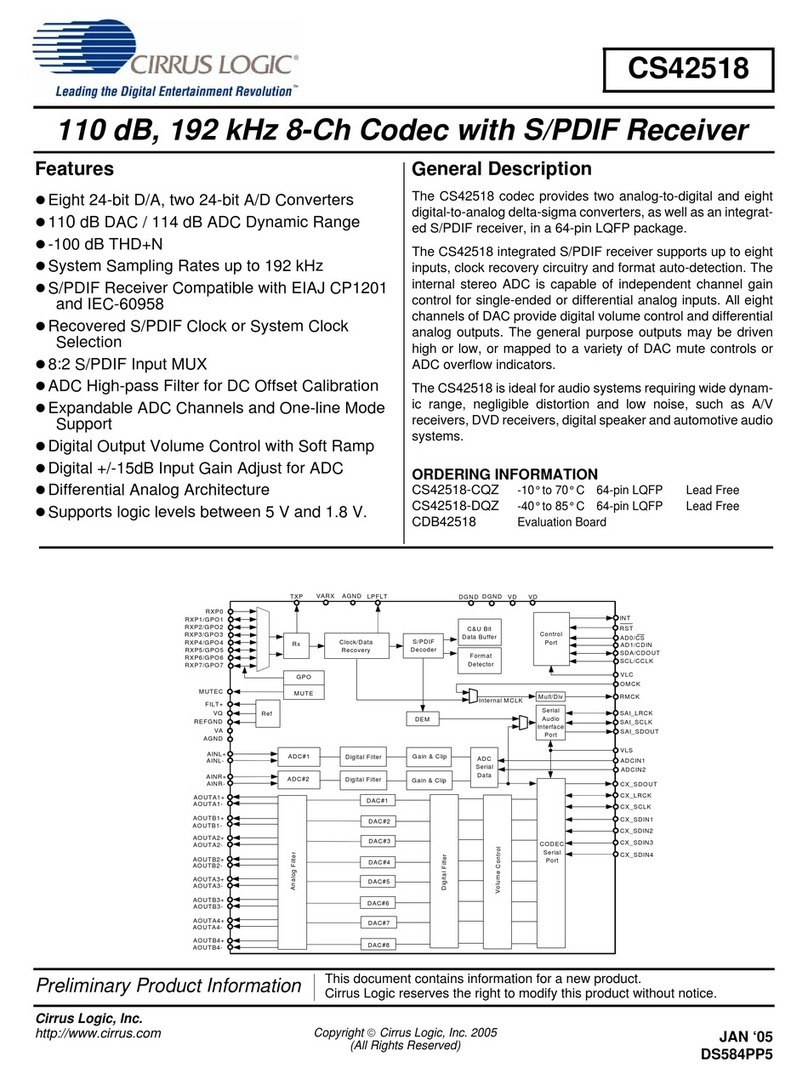
Cirrus Logic
Cirrus Logic CS42518 User manual
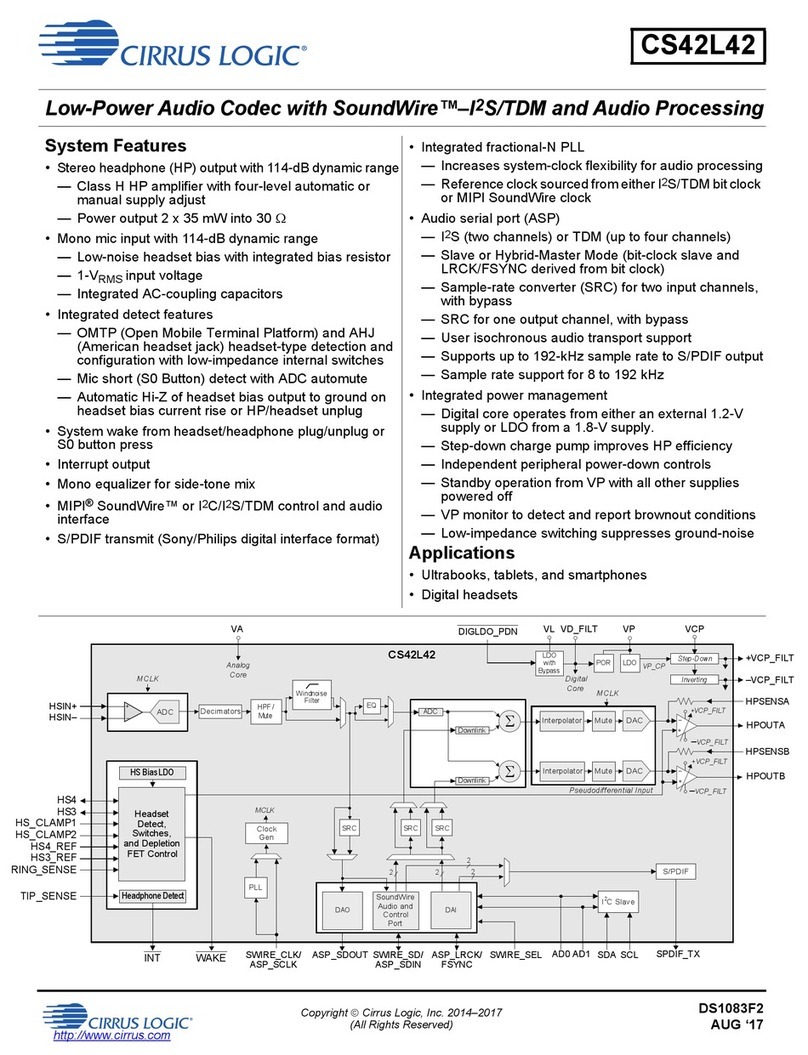
Cirrus Logic
Cirrus Logic CS42L42 User manual
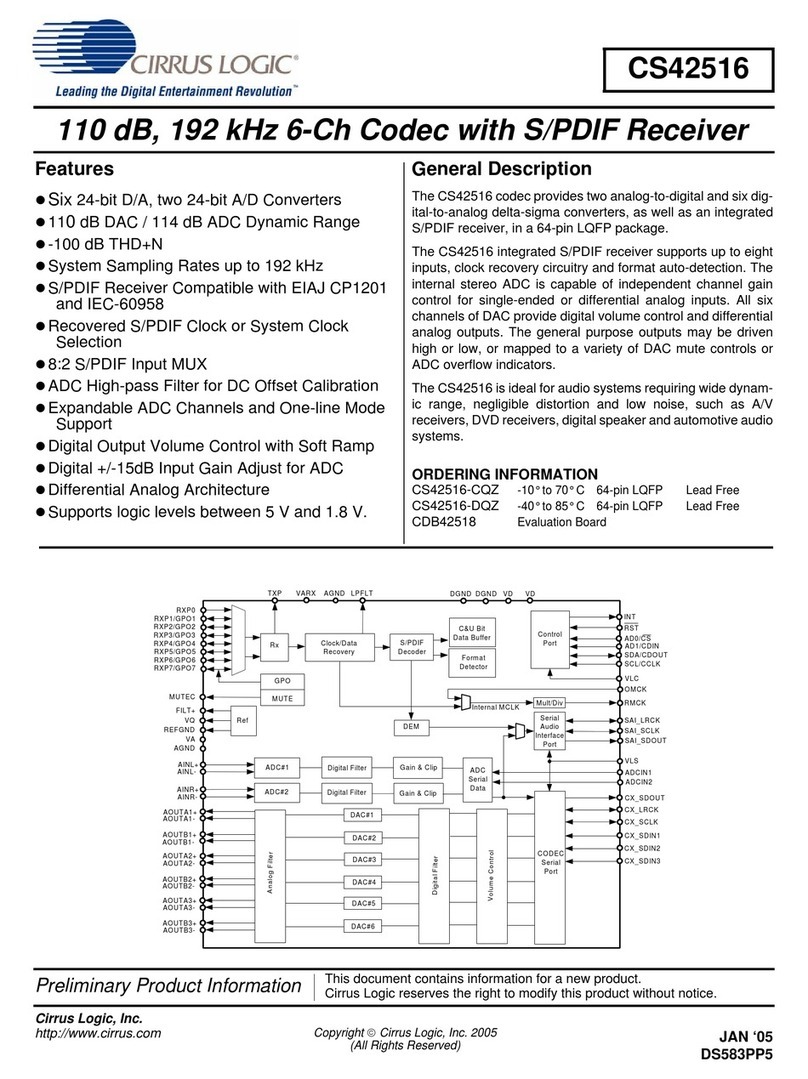
Cirrus Logic
Cirrus Logic CS42516 User manual
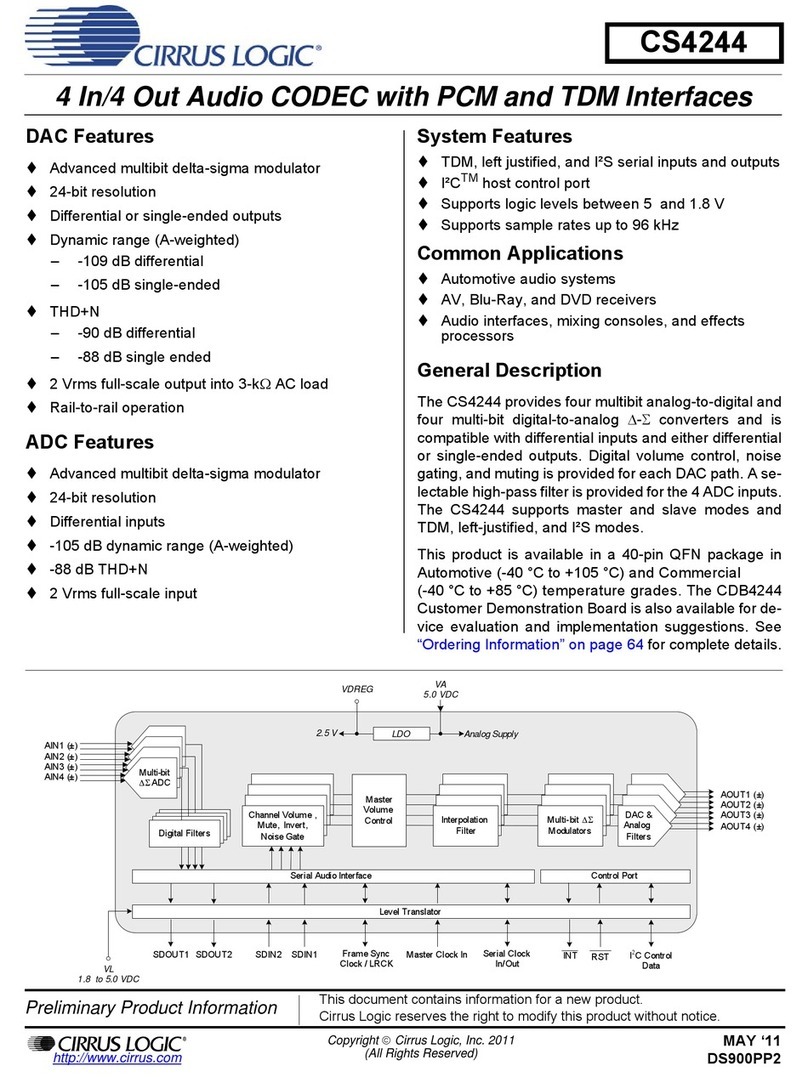
Cirrus Logic
Cirrus Logic CDB4244 User manual
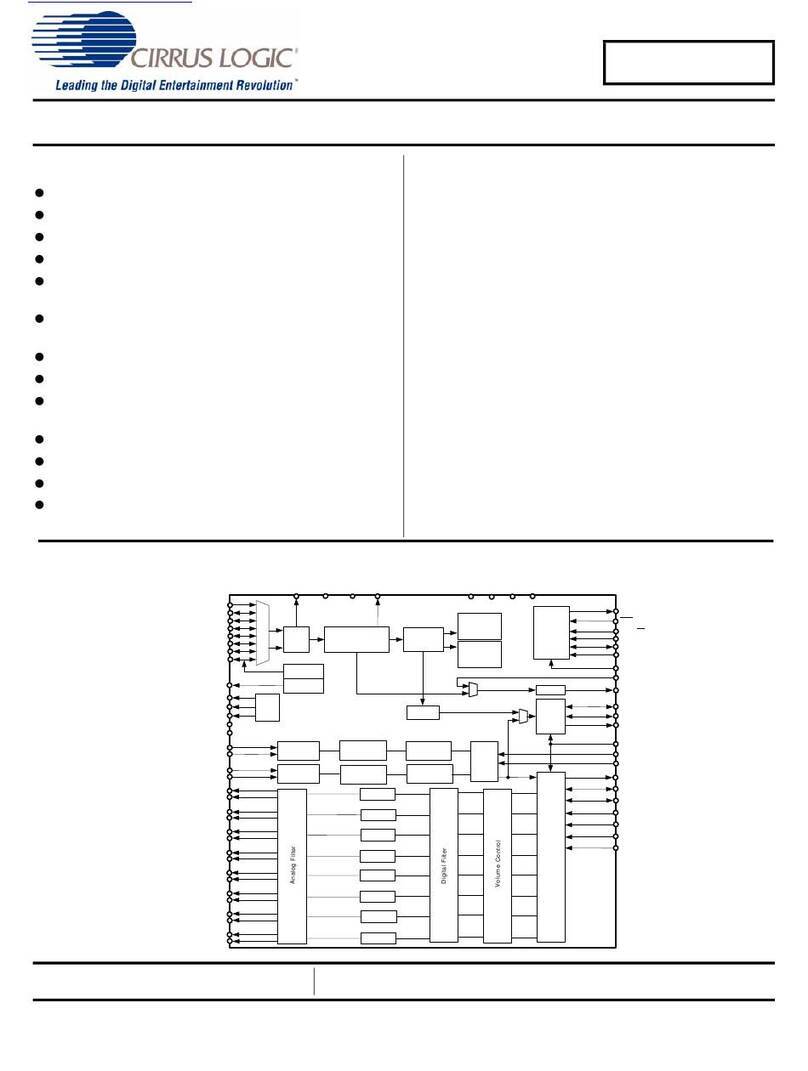
Cirrus Logic
Cirrus Logic CDB42528 User manual
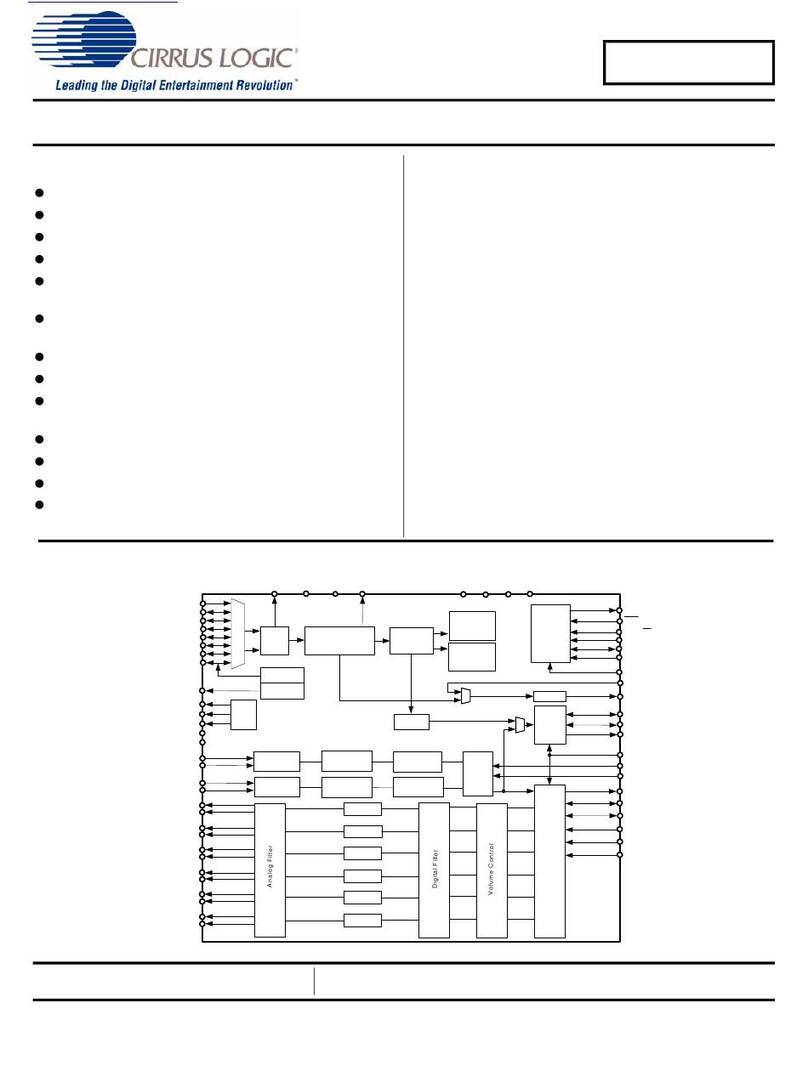
Cirrus Logic
Cirrus Logic CS42526 User manual
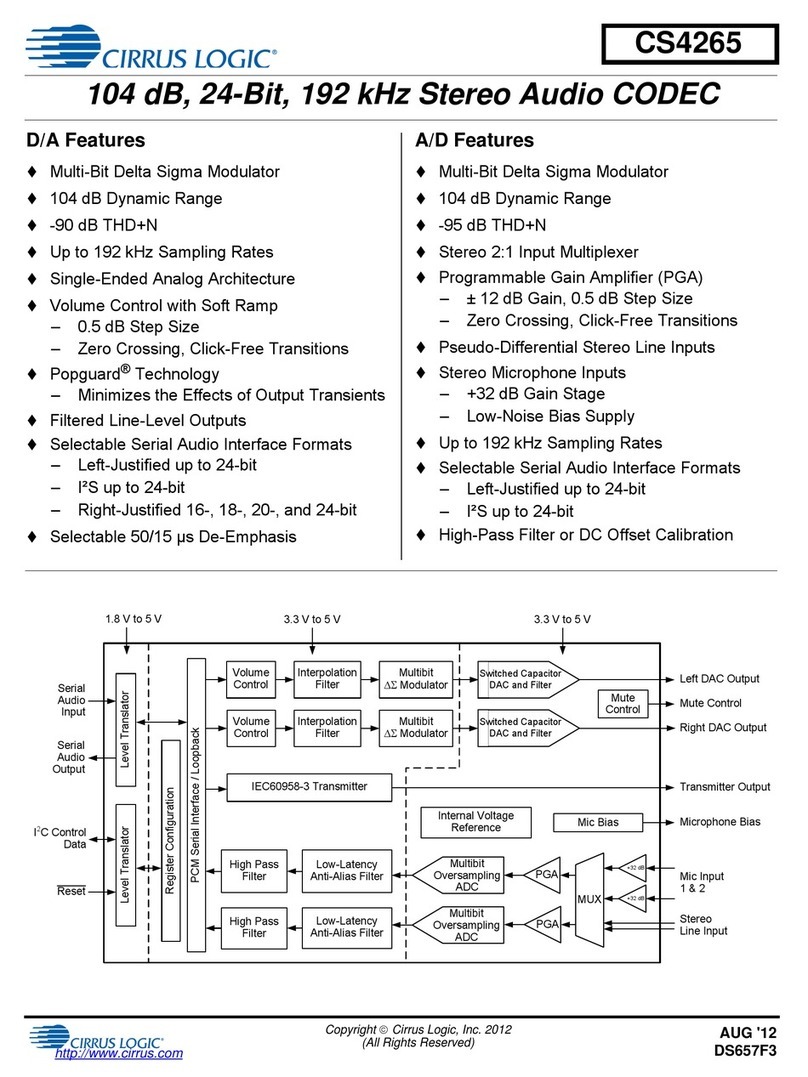
Cirrus Logic
Cirrus Logic CS4265 User manual
